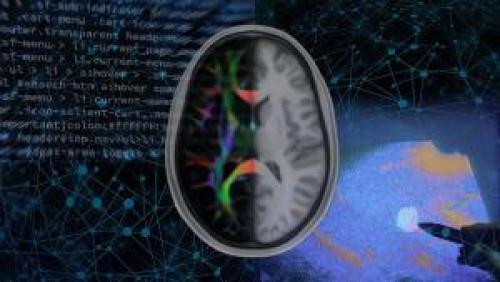NIH and radiology societies map path for translational research on AI in medical imaging
Clinical emphasis rounds out foundational research focus of earlier report.
A new report, with contributions from the National Institute of Biomedical Imaging and Bioengineering (NIBIB), part of the National Institutes of Health, provides a roadmap for translational research on artificial intelligence (AI) in medical imaging. The report identifies research priorities that leverage big data, the cloud, and machine learning for augmenting clinicians’ image planning and use to make diagnoses or assess patients’ responses to therapy.

Artificial intelligence has an expanding role to play in medical imaging. NIBIB
This report and a companion report published last month summarize conclusions from an August 2018 workshop co-organized by NIH, the Radiologic American College of Radiology (ACR), the Radiological Society of North America (RSNA), and The Academy for Radiology and Biomedical Imaging Research. The first report published April 16, 2019, maps a path forward for foundational research in AI and this second report focuses on translational research necessary to deliver AI to clinical practice.
“Radiology has transformed the practice of medicine in the past century, and AI has the potential to radically impact radiology in positive ways,” said Krishna Kandarpa, M.D., Ph.D., co-author of the report and director of research sciences and strategic directions at NIBIB. “This roadmap is a timely survey and analysis by experts at federal agencies and among our industry and professional societies that will help us take the best advantage of AI technologies as they impact the medical imaging field.”
The companion reports — co-authored by government, industry, academia and radiology specialty society leaders — have identified and prioritized initiatives to accelerate foundational and translational research in AI for medical imaging.
“This new roadmap paper gives guidance for the clinical translation of AI innovation,” said Curtis P. Langlotz, M.D., Ph.D., report co-author and RSNA Board Liaison for Information Technology and Annual Meeting. “Together, these two connected roadmaps show us how AI not only will transform the work of radiologists and other medical imagers, but also will enhance the delivery of care throughout the clinical environment.”
The authors suggest that the application of AI can impact the entire radiology process, from the clinical decision to perform diagnostic imaging, to preparation of patients for procedures, to conducting the scan, to interpretation of imaging results, and finally to the management of workflow in radiology departments. While most attention is drawn to the power of computers to aid in interpreting images, there is ongoing research on AI applications that address every aspect of the imaging process, according to the report. AI tools considered by this roadmap are algorithms for disease detection and classification, image optimization, radiation reduction, and workflow enhancement. The authors suggest that radiologists should take the lead in identifying the most important areas for AI development.
The authors identified key priorities:
•Structured AI use cases. In software development, use cases define who will use a system and for what specific goal. AI use cases should define and highlight clinical challenges potentially solvable by AI.
•Data sharing. Researchers should establish methods to encourage data sharing for training and testing AI algorithms to promote generalizability to widespread clinical practice and minimize unintended bias.
•Tools for validation and performance monitoring of AI algorithms to facilitate regulatory approval.
•Standards and common data elements for seamless integration of AI tools into existing clinical workflows.
“Although advances in foundational research are occurring rapidly, translation to routine clinical practice has been slower because we must ensure AI in medical imaging is useful, safe, effective, and easily integrated into existing radiology workflows before they can be used in routine patient care,” said Bibb Allen, M.D., report co-author and chief medical officer of the ACR Data Science Institute.
The report establishes that an important goal of the resulting roadmap is to grow an ecosystem—facilitated by professional societies, industry, and government agencies—that will allow robust collaborations between practicing clinicians and AI researchers to advance foundational and translational research relevant to medical imaging.
Source: U.S. National Institutes of Health
- 247 reads
Human Rights
Ringing FOWPAL’s Peace Bell for the World:Nobel Peace Prize Laureates’ Visions and Actions

Protecting the World’s Cultural Diversity for a Sustainable Future

The Peace Bell Resonates at the 27th Eurasian Economic Summit

Declaration of World Day of the Power of Hope Endorsed by People in 158 Nations

Puppet Show I International Friendship Day 2020

